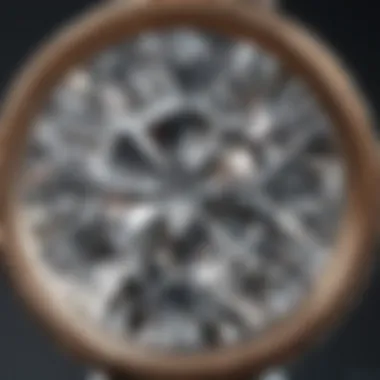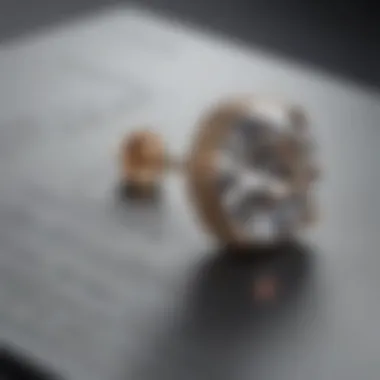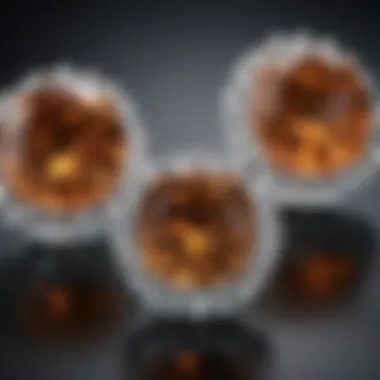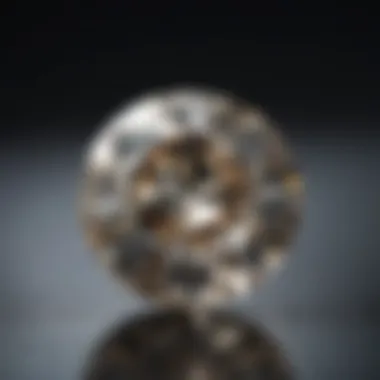Identifying Real Diamond Earrings: A Comprehensive Guide


Intro
Understanding the intricacies of diamond earrings can be a daunting task for both new enthusiasts and seasoned collectors. The allure of diamonds is significant, but so too are the imitations flooding the market. This section aims to clarify the questions surrounding authenticity by providing a framework to evaluate diamond earrings effectively.
Gemstone Overview
Diamonds are more than just precious stones; they are remarkable natural formations. Formed under immense pressure deep within the Earth, diamonds are primarily composed of carbon atoms arranged in a crystal structure. This unique composition contributes to their brilliance and durability, making them a preferred choice for jewelry, particularly earrings.
Description of the Gemstone
Diamonds are renowned for their clarity, sparkle, and variety. They come in several cuts, including round, princess, and emerald, each enhancing the gem's natural light reflection. Colorless diamonds are traditional favorites, but they also exist in a range of hues, including yellow, blue, and pink. These colors result from various impurities that affect the diamond's appearance.
Physical Properties
Diamonds possess distinct physical characteristics that set them apart from other stones:
- Hardness: Diamonds are the hardest known natural material, scoring a 10 on the Mohs scale.
- Thermal Conductivity: They efficiently conduct heat, making them unique among gemstones.
- Light Refraction: The ability to refract light creates the sparkle both enthusiasts and collectors admire.
Each of these properties plays a crucial role in identifying genuine diamonds from other materials.
Authenticity Assessment
When evaluating the authenticity of diamond earrings, several key factors must be considered. Certification from recognized bodies, such as the Gemological Institute of America (GIA), provides a reliable reference for buyers. It indicates that the diamond has undergone rigorous testing for its quality and authenticity.
A certificate from a reputable organization is your best assurance of a diamond's authenticity.
Visual Characteristics
In addition to certification, visual assessments can aid in identifying real diamond earrings. Look for the following:
- Brilliance: True diamonds exhibit high levels of brilliance and fire, creating a spectrum of light.
- Inclusions and Blemishes: Natural diamonds may have minor imperfections that are not present in synthetic versions.
- Under Magnification: Use a jeweler's loupe to inspect the diamond closely.
Practical Tests for Identification
Practical tests can further confirm authenticity:
- Fog Test: Breathe on the diamond; if it clears rapidly, it is likely real since diamonds disperse heat well.
- Water Test: Place the diamond in water. A genuine diamond sinks due to its high density, unlike some imitations.
End
With enhanced knowledge of diamond properties and evaluation techniques, enthusiasts and collectors can navigate the complexities of purchasing diamond earrings more confidently. Understanding these aspects empowers individuals to make informed choices.
The following sections will delve deeper into the market dynamics and expert purchasing tips to further enrich your understanding and grab the best value in the gemstone market.
Understanding Diamond Quality
Diamond quality is essential for anyone looking to identify real diamond earrings. Understanding the nuances of diamond grading helps enthusiasts and collectors determine the authenticity and value of their jewelry. The importance of this knowledge cannot be understated. It enables buyers to make informed decisions and avoid common pitfalls when purchasing diamonds. Knowing the quality of a diamond not only affects aesthetic appeal but also the overall investment value of the piece.
The Four Cs of Diamonds
The Four Cs of Diamonds are crucial factors that define the quality of a diamond: Cut, Color, Clarity, and Carat Weight. Each element plays a vital role in how the diamond appears and its market value.
Cut
Cut refers to how well a diamond has been shaped and faceted. The quality of the cut affects the diamond's brilliance and sparkle. A well-cut diamond reflects light beautifully, creating an impressive display. This is a popular choice because it can make even a smaller diamond look stunning. A poorly cut diamond, however, can appear dull despite a higher carat weight. Understanding cut can guide buyers in selecting diamonds that will shine.
Color
Color indicates the absence of color in a diamond. The best diamonds are nearly colorless, allowing them to reflect light effectively. The key characteristic of color grading ranges from D (colorless) to Z (light yellow or brown). A diamond with a high color grade is desirable because it maximizes brilliance. However, some buyers prefer diamonds with slight hues for personal or ethical reasons. Knowing this helps buyers appreciate the range of options available.
Clarity


Clarity assesses the presence of internal or external flaws, known as inclusions and blemishes. A diamond with high clarity has few to no imperfections, enhancing its visual appeal. The key here is that clarity impacts how light interacts with the stone. Diamonds with lower clarity grades are generally less valuable. Therefore, understanding clarity can help buyers negotiate prices and find the ideal balance between beauty and budget.
Carat Weight
Carat Weight measures the size of the diamond. A greater carat weight typically means higher value, but the relationship is not linear. It is important to note that the appearance does not solely depend on carat weight. Factors like cut and quality also play significant roles. A smaller diamond with ideal cut and clarity can appear more striking than a larger, poorly cut diamond. Buyers should consider these aspects when evaluating carat weight.
How Quality Affects Value
The quality of a diamond directly influences its market value. Higher quality often translates into a higher price. However, individual preferences can vary significantly. For example, a buyer might prioritize cut over carat weight, valuing aesthetic appeal more than size. Awareness of the Four Cs enables buyers to navigate this complex market, making educated decisions that suit their preferences and budgets.
The Importance of Certification
The significance of certification in the realm of diamond earrings cannot be overstated. Certification serves as an objective indicator of a diamond's quality and authenticity, assuring buyers that what they purchase meets certain standards. In an industry rife with simulants and imitations, possessing a certification document from a reputable grading organization not only enhances buyer confidence but also plays a crucial role in value assessment.
Obtaining certified diamonds can streamline the purchasing process. Buyers can make more informed choices based on clear criteria recognized by experts, mitigating the risk of buying inferior or synthetic stones. Moreover, certification can help in future appraisal and resale value. When sellers can provide confirmed documents, this can significantly enhance a diamond's market appeal. Thus, understanding the nuances of certification is vital for ensuring a satisfactory investment in diamond jewelry.
Recognizing Reputable Grading Organizations
GIA
The Gemological Institute of America (GIA) is perhaps the most recognized name in diamond grading. Established in 1931, GIA is known for its strict grading standards and comprehensive criteria. GIA's reports cover all four Cs: cut, color, clarity, and carat weight, providing detailed insights into a diamond's quality. One of the key characteristics of GIA is its reputation for integrity and impartiality. Buyers often choose GIA certificates due to their reliability and global acceptance.
A unique feature of GIA is that they use advanced technology and extensive research to ensure accuracy in their assessments, making their evaluations highly respected in the diamond trade. However, some may find that GIA's services can be more expensive compared to others, which could be a consideration for budget-conscious buyers.
AGS
The American Gem Society (AGS) is another highly regarded grading organization known for its focus on cut quality particularly. Founded in 1934, AGS employs a unique grading system that assesses the quality of the cut on a scale from zero to ten. This thorough approach gives buyers a clearer idea of how a diamond will perform in terms of brilliance and sparkle.
A key characteristic of AGS is its dedication to consumer protection and education, providing resources that help buyers understand their purchases better. A special aspect of AGS is that its grading reports tend to be more consumer-friendly, which can be beneficial for those new to purchasing diamonds. Nonetheless, it is essential to note that AGS might not be as widely recognized internationally compared to GIA.
IGI
The International Gemological Institute (IGI) offers another alternative for diamond certification. Founded in 1975, IGI has expanded its recognized grading across many countries. It provides a detailed description of a diamond's characteristics, including shape, weight, and any noticeable imperfections.
One advantage of IGI is that it often provides quicker turnaround times for grading services, making it a popular choice among manufacturers and retailers. Another unique feature is its widespread availability, which allows for easier access to its services compared to other organizations. However, some critique that IGI's grading may be slightly less rigorous than that of GIA or AGS, leading to potential inconsistencies in certain evaluations.
Understanding Grading Reports
Once a buyer has chosen to obtain a certified diamond, understanding the grading report becomes a key step in confirming the quality and authenticity of the stone. A grading report contains various essential details such as the diamond's dimensions, weight, and aspect ratios. It can also give insights about the grading of each of the four Cs.
Being well-informed about how to read this document can help buyers make knowledgeable choices and engage effectively when discussing their diamonds with jewelers. Additionally, familiarity with specific terms and ratings can prove beneficial in negotiating a purchase or addressing questions in an appraisal conversation. In the world of diamonds, knowledge translates directly into empowerment.
Visual Inspection Techniques
Visual inspection techniques are essential when identifying real diamond earrings. These methods leverage the unique physical properties of diamonds, allowing individuals to discern authenticity through careful observation. Effective visual inspection can reveal flaws, sparkle, and overall craftsmanship. Understanding these techniques adds a vital layer of security when buying diamonds, particularly for enthusiasts and collectors.
Evaluating Sparkle and Fire
The sparkle and fire of a diamond are crucial indicators of quality. Sparkle refers to the light dispersion that occurs as a diamond interacts with light, while fire describes the spectral colors produced during that interaction. When evaluating these two aspects, observe how light reflects off the surface and enters the stone. A genuine diamond demonstrates a mix of both attributes, creating a captivating visual effect.
Look closely for these specifics:
- Brilliance: A real diamond should have high brilliance. This means it reflects a significant amount of light, leading to a bright appearance.
- Scintillation: Observe how the stone sparkles. Genuine diamonds will scintillate even in lower light conditions.
When managing different lighting settings, the diamond should maintain its shine. If it appears dull or lifeless, it might not be a real diamond.
Checking for Bubbles and Inclusions
Real diamonds are formed under immense heat and pressure within the earth, leading to natural characteristics called inclusions. These imperfections are unique to each diamond and serve as identifying markers. In contrast, synthetic or imitation stones would often show bubbles due to their manufactured nature.
During your inspection:


- Use a 10x loupe or a jeweler's loupe to examine the stone closely. Look for small inclusions or internal features. Each real diamond will possess its unique inclusions only visible under magnification.
- Bubbles: If you see tiny bubbles inside the stone, it likely indicates a synthetic or inferior quality material.
This scrutiny helps ascertain the stone’s authenticity and can even reveal its origin.
Assessment of Setting and Mounting
The setting and mounting of a diamond earring can tell much about its authenticity. A high-quality diamond should be set in a well-crafted mount, significantly affecting its overall appearance. Poor settings often hint at cheaper imitations.
Consider these points during your inspection:
- Material quality: A real diamond usually accompanies high-quality metals like platinum, gold, or silver. Check the hallmark on the metal for authenticity.
- Craftsmanship: Look for precision in the setting. A genuine diamond earring will display expert craftsmanship.
The detail in the setting can influence not only the aesthetic value but also the stone's security within the mounting.
"A good visual inspection can help you save money and avoid future disappointment."
Practical Testing Methods
Practical testing methods are essential for anyone looking to verify the authenticity of diamond earrings. These tests go beyond visual inspections and offer tangible results that can help in determining whether a piece is made of real diamonds or if it is merely an imitation. Understanding these methods can save significant financial and emotional investment, especially for enthusiasts and collectors. Key benefits include increased confidence when making purchases and a deeper appreciation for the value of genuine gemstones. Each method has its unique features, advantages, and precautions to consider.
The Water Test
The water test is a simple yet effective way to evaluate the authenticity of diamonds. When placed in water, a genuine diamond tends to sink quickly due to its density. This test utilizes the contrasting properties of various materials, as many imitations, such as cubic zirconia, have different buoyancy and might float or sink slower.
To perform the water test:
- Fill a clear glass with water.
- Gently drop the earring into the glass.
- Observe the behavior of the earring.
If the earring sinks rapidly and stays submerged, it is likely a real diamond. If it floats or does not sink immediately, further testing is recommended. However, this test is not definitive on its own, as some natural stones can behave similarly.
Fog Test Application
The fog test is another straightforward method to check for authenticity. Diamonds have unique thermal conductivity, which allows them to disperse heat quickly. When you breathe on a diamond, it should clear up rapidly, usually within just a second. This feature contrasts with synthetic stones, which may retain condensation for a longer period.
To execute the fog test, follow these steps:
- Hold the diamond earring close to your mouth.
- Exhale gently, creating fog on the surface of the stone.
- Watch how quickly the fog dissipates.
If the fog vanishes instantly, the diamond is likely real. In contrast, a slower dissipation can indicate a not genuine stone. This test is easy but should be combined with other methods for more reliable results.
Utilizing a Loupe or Microscope
The use of a loupe or microscope provides an in-depth look at the characteristics of a diamond, making it an invaluable tool for assessment. These devices allow for closer inspection of imperfections, inclusions, and the cutting style of the diamond, all of which contribute to its overall quality.
To use a loupe or microscope effectively:
- Place the diamond earring under the device's lens.
- Look for small details like inclusions, which can hint at authenticity.
- Check for any signs of machining that indicate a synthetic origin.
A genuine diamond typically shows natural birthmarks unlike imitations that often lack these unique identifiers. This method can provide insight into the stone's grading and enhances the buyer's ability to make informed decisions.
In summary, practical testing methods such as the water test, fog test, and using a loupe or microscope serve as essential tools in identifying real diamond earrings. Each method has its own strengths and limitations, and combining them increases the likelihood of an accurate assessment.
Market and Ethical Considerations
The diamond market is evolving, presenting both challenges and opportunities for consumers. Understanding market dynamics and ethical considerations is crucial when identifying real diamond earrings. This knowledge empowers buyers to make decisions that align with their values while also ensuring they invest in authentic pieces.
Trends in Synthetic Diamonds
Synthetic diamonds are gaining traction, making it essential for buyers to understand this segment. These lab-created stones share physical and optical properties with natural diamonds but come at a lower price point. They appeal to consumers who prioritize ethical sourcing and sustainability. However, synthetic diamonds lack the same resale value and exclusivity as natural ones. Therefore, buyers must discern their preferences and the implications of owning synthetic versus natural diamonds.
The defining characteristics of synthetic diamonds include:


- Lower cost compared to natural diamonds
- Eco-friendliness owing to reduced mining impact
- Rapid production cycles
Despite these advantages, consumers should be aware that the market for synthetic diamonds is expanding, and their presence may influence perceptions of what constitutes a "real" diamond. Understanding these trends allows consumers to navigate the market more effectively.
Understanding Ethical Sourcing
Ethical sourcing is a growing concern among consumers. Buyers increasingly seek diamonds that are mined responsibly, with minimal environmental impact and fair labor practices. The term "blood diamonds" refers to stones mined in conflict zones, where profits fund violence and human rights abuses. Hence, consumers should prioritize diamond vendors who provide transparency about sourcing practices. This involves asking for certifications and proof of supply chains.
To ensure ethical practices in diamond purchases, consider the following:
- Seek out certified diamonds: Organizations like the Responsible Jewelry Council and Fair Trade Certified Diamonds offer assurance of ethical sourcing.
- Ask about supply chains: Vendors should outline their diamond sourcing methods, revealing whether they adhere to responsible mining guidelines.
- Support local initiatives: Some vendors engage in community-based projects that enhance the lives of miners and their families.
Being aware of these factors not only reinforces ethical consumption but also enhances market integrity, ensuring that the diamonds one purchases contribute positively to society.
"Being informed about diamond sourcing helps ensure your purchase reflects your values."
Purchasing diamond earrings is not just about aesthetics or value; it extends to the broader impact of that purchase. Consumers must remain vigilant in identifying genuine diamonds and understanding the implications of their buying choices in today’s dynamic market.
Professional Appraisal
A professional appraisal of diamond earrings serves as a critical step for anyone investing in or owning high-quality gemstones. It goes beyond mere valuation; it provides essential insights into the authenticity and quality of the diamonds involved. Appraisal typically involves a thorough examination by a qualified gemologist who uses specialized equipment to assess the diamonds in detail. This evaluation can establish both the market value of the earrings and ensure they meet the standards of excellence expected in the industry.
When to Seek a Professional
Knowing when to seek a professional appraisal can save a potential buyer from costly mistakes. Here are a few key scenarios:
- Purchasing Vintage or Antique Pieces: If the diamond earrings are part of a vintage collection, a professional appraisal is essential. Historical pieces often possess unique traits that require expert knowledge to evaluate.
- Insurance Purposes: Insurance companies generally require a professional appraisal to cover the true value of the earrings. This documentation can protect the owner in case of theft or loss.
- Selling or Reselling: When planning to sell diamond earrings, having a professional appraisal can increase confidence among buyers. An appraisal provides credibility to the seller, showing that the earrings have been evaluated by an expert.
- Gift Considerations: For those looking to buy diamond earrings as a gift, especially for major life events, ensuring authenticity and value through professional appraisal can add worth to the sentimental gesture.
What to Expect from an Appraisal
Understanding the appraisal process can demystify its purpose and value. When you visit an appraiser, expect the following:
- Detailed Examination: The appraiser will conduct a thorough examination using tools like a loupe, microscope, and other equipment to assess clarity, cut, and color.
- Documentation: You will receive a detailed report that outlines the findings of the appraisal. This documentation usually includes photographs, descriptions, and the estimated market value of the earrings.
- Open Discussion: Many appraisers will discuss their findings with you, explaining each aspect of your diamond earrings’ quality and characteristics.
- Advice on Care: A professional may also provide insights on how to care for your diamond earrings to maintain their value and appearance over time.
"A professional appraisal is not just a luxury; it is a necessary step in safeguarding your investment."
This process plays an essential role in empowering consumers with knowledge about their valuables. By obtaining an appraisal, you gain assurance and clarity that is crucial in the intricate world of diamonds.
Consumer Awareness and Protection
Consumer awareness and protection are critical aspects to consider when purchasing diamond earrings. It is essential not just to understand what you are buying but also to be equipped with the knowledge that enables you to make informed decisions. Being aware of potential pitfalls can save you both time and money, and most importantly, ensure that your purchasing experience is safe and satisfactory.
In the realm of jewelry, particularly with diamond earrings, the market is rife with imitation products and questionable sales tactics. This highlights the need for consumers to educate themselves on the key factors that define genuine diamond earrings. The right knowledge enables buyers to differentiate between real diamonds and lab-grown or synthetic alternatives. Understanding the nuances of diamond quality, certification, and visual traits are essential parts of this process.
The benefits of consumer awareness include:
- Avoiding Fraud: By knowing the red flags to look for, you can steer clear of fraudulent vendors and counterfeit products.
- Informed Choices: Better understanding of the market allows you to make decisions that align with your expectations and budget.
- Value Retention: Knowledge about grading and authenticity can help ensure that you invest in items that hold their value over time.
Additionally, consumer protection laws provide frameworks that safeguard buyers from fraudulent practices. Familiarity with these laws can provide peace of mind. It's not just about buying a pair of earrings; it’s about knowing your rights and being vigilant about what you purchase.
"An informed customer is a powerful customer."
Red Flags When Buying Diamond Earrings
Recognizing red flags when buying diamond earrings is crucial in avoiding regretful post-purchase realizations. Here are key indicators that may suggest a less-than-authentic product or an unreliable seller:
- Unbelievably Low Prices: If a deal seems too good to be true, it probably is. Genuine diamond earrings come with a value that is rarely discounted beyond a certain point.
- Lack of Certification: Authentic diamonds should come with certification from a reputable organization. A vendor unable or unwilling to provide this should raise your suspicion.
- Inconsistent Information: Beware of sellers who struggle to provide clear and concise information about their products, including the source of the diamonds and their quality.
- Unclear Return Policy: A vendor should offer a clear and reasonable return or exchange policy. If terms are vague or restrictive, think twice.
- Overly Aggressive Sales Tactics: If a salesperson is overly pushy or rushes you to make a decision, it can be a sign of a scam.
Educating yourself on these red flags can save you from potential scams and ensure a better buying experience.
Building Knowledge before Purchase
Building knowledge before purchasing diamond earrings is an investment in your confidence as a consumer. Knowing about the products can greatly enhance your buying experience. Here are some effective ways to build your knowledge:
- Research Diamond Quality: Understand the Four Cs: Cut, Color, Clarity, and Carat Weight. Each of these factors heavily influences the overall quality and value of diamonds.
- Learn about Certification: Familiarize yourself with the grading organizations such as the Gemological Institute of America (GIA) and the American Gem Society (AGS). Knowing what credible certifications look like can guide your selection.
- Follow Industry Trends: Trends in diamonds, including synthetic stones and ethical sourcing, can shape your purchasing decision. Keeping informed about these trends can help you align your purchase with your values.
- Engage with Communities: Participate in forums like Reddit or Facebook groups focused on diamonds and jewelry. Engaging with experienced collectors and enthusiasts can provide valuable insights.
- Visit Local Jewelers: Don’t underestimate the benefit of talking to professionals in local jewelry stores. They can offer practical advice and might help clarify any doubts you have.
By arming yourself with knowledge, you enhance your ability to navigate the market effectively. This preparation gives not just peace of mind but also a sense of empowerment when making a purchase.







